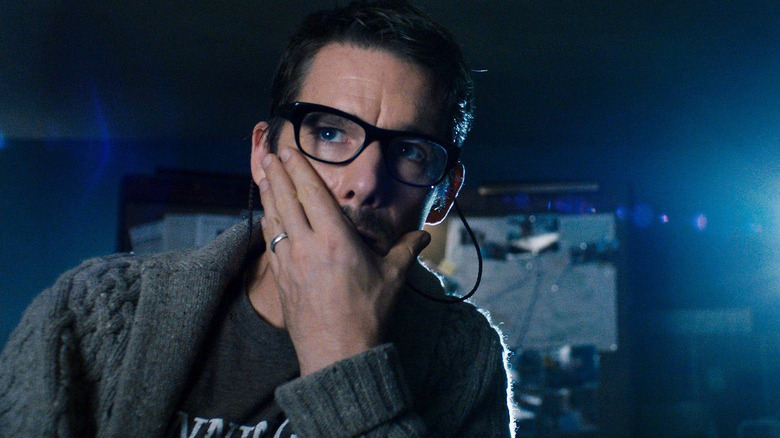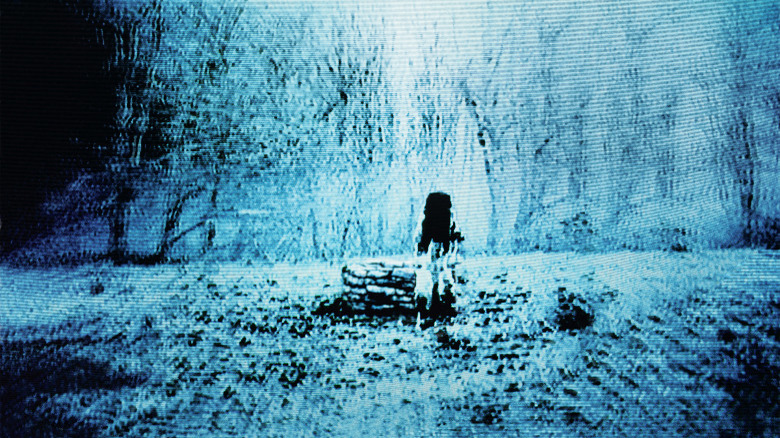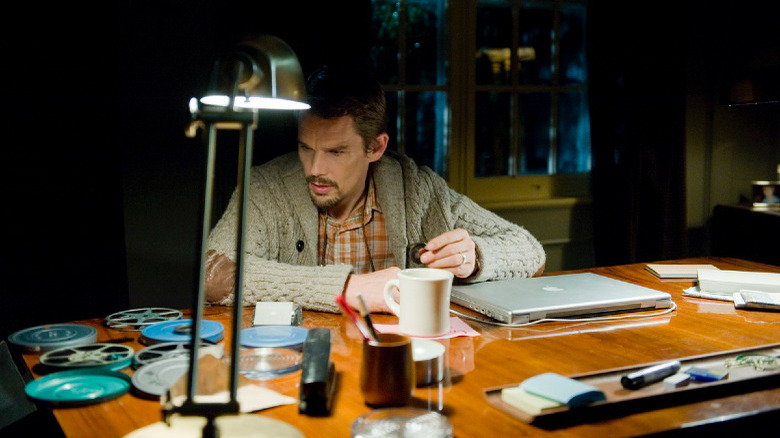The Idea Behind Sinister's Story Started With A Viewing Of The Ring
Director Scott Derrickson's "Sinister" turns 10 in 2022, and it's only grown more topical over the last decade. The film, for those not aware, stars Ethan Hawke as a true-crime author who knowingly moves his family to a house where the previous occupants were murdered under mysterious circumstances. It's not that true-crime works were unpopular in 2012 when "Sinister" came out (quite the opposite), but they also weren't the cottage industry they are today. As the sub-genre continues to grow in popularity, a horror movie that subtly questions when true-crime projects cross the blurry line between documentation and exploitation is all the more worthy of a revisit.
The plot of "Sinister" makes the power of media to do real-world harm very literal. Upon moving into his family's new home, Hawke's character uncovers a box of home videos in the attic. Much to his horror, these short films depict the ghastly deaths of other families, all of whom (as he comes to learn in time) are connected to a pagan deity known as Bughuul, aka "Mr. Boogie." Moreover, by bringing his loved ones to their new home and watching these videos, Hawke's protagonist has put both them and himself directly in the line of fire.
Far from the first horror movie to center on cursed "found-footage" that will lead to your death if you watch it, it's clear that "Sinister" was in part inspired by another famous horror title with a similar premise: "The Ring." In fact, co-writer C. Robert Cargill has always been more than happy to admit as much. As he revealed to Complex in 2012, the very first scene in "Sinister" came to him after seeing the U.S. version of "The Ring" in theaters 10 years earlier.
'That stuck with me'
"Before you die, you see the ring."
So read the classic tagline for Gore Verbinski's "The Ring," itself a movie based on Hideo Nakata's 1998 Japanese horror film "Ringu" and the 1991 Koji Suzuku novel of the same name. It also might as well have been the law of the land among horror fans in 2002. There was just no getting around seeing the mega-popular movie if you loved the genre, and, sure enough, C. Robert Cargill was among those who trekked out to a theater to watch it one fateful day.
When he returned home that night, Cargill decided to take a nap, only to suffer quite the nightmare. In his dream, he walks up to the attic of his house and finds a box filled with Super-8 film reels. After loading one of the reels into a projector, he discovers it contains horrifying footage of a family being hung to death from a tree all at once. "That stuck with me," he told Complex, adding:
"That haunted me for awhile, and I figured, there's a story there. I thought, If I find the right story, that could be a pretty cool movie. And I think we may have made one."
Cargill's dream would go on to provide the basis for the opening scene in "Sinister," which shows a home video of a family being killed by hanging. What's interesting is how, on the surface, this "found-footage" is very different from the cursed videotape in "The Ring." Where you can clearly grasp what's happening with the "Sinister" video, the VHS tape in "The Ring" is filled with disturbing yet enigmatic and seemingly unrelated visuals. On a deeper level, though, they both tap into our fears about the potentially harmful effects of the media we intake.
Finding the right story
These similarities aside, "The Ring" and "Sinister" stand firmly apart from one another in terms of their overarching plots and themes. Where the former explores the horror of motherhood and tech-related anxieties of the aughts, "Sinister" acts as a cautionary tale about exploiting others' suffering (via true-crime stories) and putting your personal, ego-serving interests above those of the people who depend on you. It took nine years for C. Robert Cargill to settle on that story, which also meant he had to hold onto the thought of his terrible nightmare all that time. As unpleasant as this was, however, he was happy with the final result:
"It took me a long time to find the right story. It was something I played around with every so often when I'd be at work and had nothing to do. I would start running through all the permutations of how the story's been told before, where it can go wrong, and it took me all of those years of it being this hobby of putting it together before it became what you see on screen."
Ten years later, "Sinister" has earned its place as one of the best and most influential mainstream horror movies to emerge from the 2010s, flaws and all. And much like Cargill and Scott Derrickson's most recent horror film, "The Black Phone," it has some valuable lessons to impart, so far as true-crime stories are concerned.
You can stream "Sinister" on Peacock and various other platforms.


